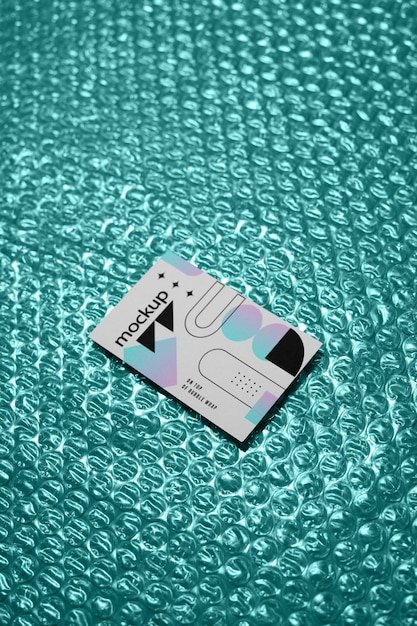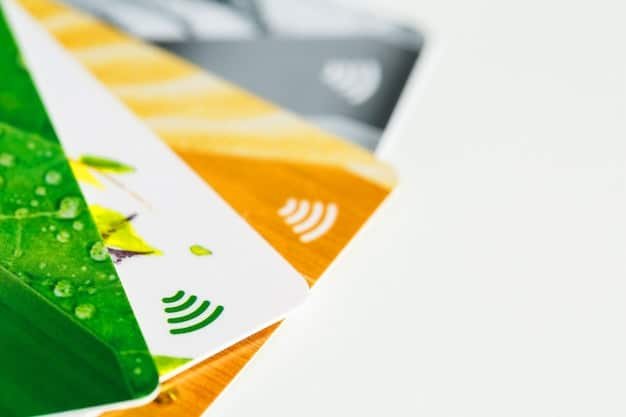The Environmental Impact of Credit Cards: Sustainable Options & Trends in the US

The environmental impact of credit cards stems from plastic production, electronic waste, and carbon emissions associated with their use; however, sustainable card options made from recycled materials and eco-conscious consumer trends are emerging to mitigate these effects within the US market.
The environmental impact of credit cards is a growing concern, prompting consumers and card issuers in the US to seek more sustainable alternatives. From the plastic they’re made of to the carbon footprint of transactions, credit cards have a significant environmental footprint. Let’s explore the challenges and emerging solutions.
Understanding the Carbon Footprint of Credit Cards
Credit cards, seemingly simple tools for transactions, contribute to a complex web of environmental concerns. Their impact extends from the materials used in their production to the energy consumed during their use.
Let’s examine the various stages where credit cards leave a carbon footprint.
The Manufacturing Process
The production of traditional credit cards relies heavily on polyvinyl chloride (PVC), a type of plastic. PVC production is energy-intensive and releases harmful chemicals into the environment. The extraction of raw materials, the manufacturing process itself, and the transportation of cards all contribute to greenhouse gas emissions.
E-Waste Disposal
When credit cards expire, they often end up in landfills, contributing to electronic waste (e-waste). E-waste contains hazardous materials like heavy metals, which can leach into the soil and water, posing risks to ecosystems and human health.
Transaction-Related Emissions
Each credit card transaction, while seemingly small, requires energy to power data centers that process the payments. These data centers consume vast amounts of electricity, often generated from fossil fuels, further adding to the carbon footprint.

The environmental impact assessment of credit card usage necessitates a comprehensive strategy, factoring in not only the production of the cards but also the broader implications of their use and eventual disposal.
Therefore, several key strategies can be adopted to mitigate these adverse effects:
- Transition to eco-friendly materials like recycled plastics or biodegradable alternatives.
- Implement responsible disposal programs for expired cards.
- Promote digital payment methods and reduce reliance on physical cards.
By addressing these issues, stakeholders can minimize the environmental impact of credit cards and promote a more sustainable financial ecosystem.
Analyzing the Plastic Consumption of Credit Card Production
The pervasive use of plastic in credit card production poses a significant environmental challenge. Traditional credit cards are primarily made from PVC, a material known for its durability but also its environmental drawbacks.
The lifecycle of a plastic credit card involves several stages with environmental repercussions.
Extraction of Raw Materials
Producing PVC requires extracting fossil fuels like petroleum and natural gas. This extraction process can disrupt ecosystems and release greenhouse gases.
Manufacturing PVC
The manufacturing of PVC involves energy-intensive processes and the use of hazardous chemicals such as chlorine. These processes release pollutants into the air and water, contributing to environmental degradation.
Card Production
Converting PVC into credit cards requires additional energy and resources. The process involves melting, molding, and printing, all of which have an environmental impact.

Plastic pollution poses a significant threat to both the environment and public health, necessitating urgent and sustainable solutions. Mitigation involves several key strategies:
Consider biodegradable plastic alternatives to reduce their environmental impact.
- Use recycled plastics, as they require less energy to produce.
- Use bioplastics derived from renewable resources, such as cornstarch or sugarcane.
- Incorporate additives that promote faster degradation.
Adopting these strategies can help reduce the accumulation of plastic waste in landfills and oceans, safeguarding ecosystems and mitigating the adverse effects of plastic pollution.
Emergence of Sustainable Card Options in the US
As environmental awareness grows, sustainable card options are gaining traction in the US. These cards aim to reduce the environmental impact associated with traditional plastic cards.
Several sustainable card options are emerging, each with its unique approach to reducing environmental harm.
Recycled Plastic Cards
These cards are made from recycled plastics, such as ocean plastic or post-consumer waste. By utilizing recycled materials, these cards reduce the demand for virgin plastic and help clean up existing plastic pollution.
Biodegradable Cards
Biodegradable cards are made from materials that can decompose naturally under specific conditions. These materials include polylactic acid (PLA) derived from cornstarch and other plant-based alternatives.
Metal Cards
While not inherently eco-friendly, some metal cards are designed to last longer, reducing the frequency of card replacements. Additionally, some metal card issuers offer recycling programs for expired cards.
Sustainable cards offer a promising avenue for reducing the ecological footprint of financial transactions, with their long-term effects dependent on factors such as material sourcing, manufacturing practices, and consumer behavior.
Here are some factors affecting their widespread adoption:
- Increased awareness among consumers
- Greater availability of these cards
- Comparable pricing to traditional cards
These factors can contribute to a broader acceptance and use of sustainable credit cards, fostering a more environmentally responsible financial sector.
Consumer Trends Driving the Demand for Eco-Friendly Cards
The demand for eco-friendly cards is being driven by a growing awareness among consumers about the environmental impact of their purchasing decisions. More and more individuals are seeking ways to align their spending habits with their values, and eco-friendly credit cards offer a tangible way to do so.
Various consumer trends are fueling the rise of eco-friendly cards.
Environmental Consciousness
Consumers are increasingly aware of the environmental consequences of their choices. They are actively seeking products and services that minimize harm to the planet.
Socially Responsible Investing
Many consumers are interested in supporting companies that prioritize environmental sustainability and social responsibility. Eco-friendly credit cards align with this trend, allowing consumers to support environmentally conscious card issuers.
Millennial and Gen Z Influence
Millennials and Generation Z are particularly concerned about environmental issues. These generations are more likely to support businesses that are committed to sustainability, and they are driving the demand for eco-friendly products and services, including credit cards.
These trends underscore a clear shift towards eco-conscious consumerism, with individuals actively seeking ways to mitigate their environmental impact through informed purchasing decisions.
Consider these key drivers:
- Transparency regarding the environmental impact and the sustainable practices
- Cards that offer rewards or incentives for eco-friendly purchases
- Partnerships with environmental organizations
Financial institutions can capitalize on this trend by offering eco-friendly credit cards that resonate with environmentally conscious consumers, bolstering both sustainability and customer loyalty.
Comparing Traditional vs. Sustainable Credit Cards: A Lifecycle Analysis
To effectively evaluate the environmental impact of credit cards, a lifecycle analysis is essential. This approach examines the entire lifespan of a card, from raw material extraction to disposal, to identify areas where environmental harm can be minimized.
The lifecycle analysis highlights key differences between traditional and sustainable credit cards.
Material Sourcing
Traditional cards rely on virgin PVC, while sustainable cards use recycled plastics or biodegradable materials. Sustainable sourcing reduces the demand for new resources and minimizes pollution.
Manufacturing Processes
The manufacturing of traditional cards involves energy-intensive processes and the use of hazardous chemicals. Sustainable card production aims to reduce energy consumption and utilize environmentally friendly chemicals.
End-of-Life Disposal
Traditional cards often end up in landfills, contributing to e-waste. Sustainable cards are designed to be recycled or composted, minimizing their impact on the environment.
Lifecycle assessments facilitate detailed comparisons, emphasizing the specific ecological advantages that sustainable cards hold over their conventional counterparts. This comparison enables consumers to make environmentally conscious choices based on data-driven insights.
Key metrics analyzed include:
- Carbon footprint
- Water usage
- Waste generation
By examining these metrics, stakeholders can quantify the environmental benefits of sustainable cards and drive further improvements in their design and production.
Government Regulations and Industry Initiatives for Greener Credit Cards
Government regulations and industry initiatives play a crucial role in promoting the adoption of greener credit cards. By setting standards and providing incentives, policymakers and industry leaders can encourage the development and use of more sustainable card options.
Several initiatives are underway to promote greener credit cards.
Extended Producer Responsibility (EPR)
EPR schemes hold producers responsible for the end-of-life management of their products. In the context of credit cards, EPR could require card issuers to implement recycling programs for expired cards.
Tax Incentives
Governments can offer tax incentives to companies that produce or use sustainable credit cards. These incentives can help level the playing field and encourage wider adoption.
Eco-Labeling
Eco-labeling programs provide consumers with information about the environmental performance of products. Credit cards that meet certain sustainability criteria can be awarded an eco-label, making it easier for consumers to identify and choose greener options.
Legislative frameworks and voluntary agreements are pivotal in steering both businesses and consumers toward environmentally conscious behavior. Regulations can set minimum standards, while industry-led initiatives can foster innovation and collaboration.
Looking ahead, these developments are crucial:
- Advancing eco-labeling schemes
- Creating public awareness campaigns
- Promoting the creation and adoption of eco-friendly alternatives.
By harnessing the combined influence of regulatory action and private sector innovation, the financial industry can substantially decrease its environmental footprint and promote ecological balance.
| Key Aspect | Brief Description |
|---|---|
| 🌱 Materials | Sustainable cards use recycled or biodegradable plastics instead of PVC. |
| ♻️ E-Waste | Sustainable options aim to reduce landfill waste through recycling or composting. |
| 📊 Consumer Trends | Increasing demand for eco-friendly products drives the shift to greener cards. |
| 📜 Regulations | Government and industry initiatives promote sustainable practices in card production. |
Frequently Asked Questions
▼
▼
▼
▼
▼
Conclusion
Ultimately, the move toward sustainable credit cards reflects a broader shift in consumer values and corporate responsibility. By embracing eco-friendly materials, reducing waste, and supporting environmentally conscious initiatives, the financial industry can play a significant role in creating a more sustainable future. As consumer awareness continues to grow, the demand for greener financial products will likely drive further innovation and adoption, paving the way for a more environmentally responsible financial ecosystem.





